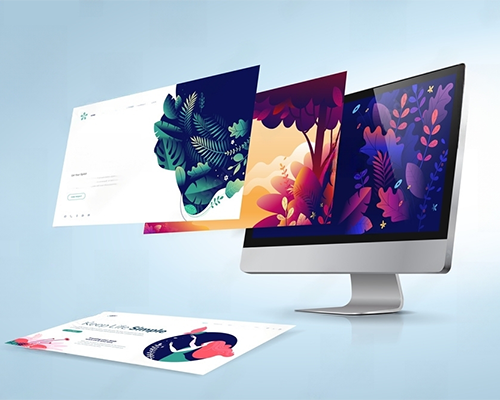Unlocking the Potential of Negative Space: Elevate your Website Design

In the world of website design, every element matters. While it’s essential to focus on content, color schemes, and images, it’s equally crucial to understand the significance of negative space, also known as white space. Negative space refers to the unoccupied areas in a design, and it plays a vital role in creating balance, readability, and visual appeal.
In this article, we will explore the art of using negative space in website design to enhance user-experience and make your designs stand out, with real-life examples to inspire your creativity.
1. Understanding Negative Space
Negative space is the area between and around elements in a design that is devoid of content. It can be in the form of white space, colored space, or even textured backgrounds. It provides breathing room for the design, allowing the content to shine and guiding the user’s attention to the important elements.
Take, for example, the website of a minimalist clothing brand, where the ample white space
surrounding product images creates a sense of elegance and sophistication, drawing attention to the products themselves.
2. Achieving Balance and Focus
Negative space helps in achieving balance by distributing the elements evenly across the design. It creates visual harmony and prevents overcrowding. By strategically using negative space, you can draw attention to specific elements and guide users through the content in a structured manner.
A classic example is the website of a luxury hotel, where spacious margins around text and images create a sense of tranquility and allow the viewer’s eyes to rest, resulting in a more enjoyable browsing experience.
3. Enhancing Readability and Clarity
A cluttered website can overwhelm users and make it difficult for them to absorb the information. Negative space helps improve readability and clarity by giving text and other content elements room to breathe. By using ample spacing between paragraphs, headings, and images, you can make the content more legible and enjoyable to read.
For instance, a blog website that utilizes generous spacing between paragraphs and sections creates a clean and organized layout, making it easier for readers to engage with the content.
4. Highlighting Calls to Action
Calls to action (CTAs) are crucial for conversions on websites. By surrounding CTAs with negative space, you can make them more prominent and visually appealing. The empty space around a CTA button creates focus and draws the user’s attention, increasing the likelihood of interaction.
Consider the website of a subscription-based service, where a bold CTA button stands out against ample white space, and guiding users towards the desired action.
5. Conveying Simplicity and Elegance
Negative space is often associated with simplicity and elegance in design. By embracing minimalism and using ample white space, you can create a clean and sophisticated look. This approach not only makes the design visually appealing but also gives a sense of professionalism and modernity.
Take inspiration from the website of a high-end furniture brand, where a minimalistic design approach and generous white space create an atmosphere of luxury and sophistication, allowing the products to take center stage.
6. Creating a Visual Hierarchy
Negative space can help establish a clear visual hierarchy on your website. By using varying amounts of space around different elements, you can indicate their importance and guide users’ attention. Important elements can be given more breathing room, while less important elements can have tighter spacing.
An excellent example is an online portfolio where larger negative space is applied around featured projects, indicating their significance and encouraging exploration.
7. Emphasizing Visual Elements
Negative space can be used to amplify the impact of visual elements such as images, videos, or graphics. By allowing these elements to occupy a significant portion of the design while surrounding them with generous negative space, you can create a powerful visual impact and draw the user’s attention.
For instance, a photography portfolio website, can utilize negative space to provide breathing room around each photograph, allowing them to capture attention and evoke emotions effectively.
8. Maintaining Mobile-Friendly Designs
With the growing number of mobile users, designing for smaller screens has become crucial. Negative space plays a vital role in ensuring a mobile-friendly experience. By leaving enough space between elements, you make the design more touch-friendly and prevent accidental clicks or taps.
An example is a mobile app landing page, where adequate spacing between interactive elements enhances usability on smaller touch screens.
Here are some real-life examples of how negative space was used;
- The WordPress Experts UG website is a good reference in harnessing the negative space idea in its website design and some of the recent work we have done.
- The Apple website uses negative space to create a sense of simplicity and elegance. The homepage is dominated by a large image of a product, with very little text. This creates a sense of spaciousness and openness on the page.
- The Nike website uses negative space to create a sense of movement and energy. The homepage is full of vibrant colors and images, but the negative space helps to create a sense of balance and order.
- The Airbnb website uses negative space to create a sense of warmth and coziness. The homepage features images of people enjoying themselves in different Airbnb listings. The negative space helps to create a sense of openness and spaciousness on the page.
In conclusion, mastering the art of negative space in website design can significantly enhance user experience and make your designs more visually appealing and more user-friendly. By understanding the power of empty space, you can create a harmonious and balanced design that guides users through the content with ease. Embrace negative space, let it breathe, and watch as it transforms your website into a visually stunning and user-friendly platform thus effectively achieving your goals.
Related article: The Importance of User Experience in Website Design
—
Do you need assistance with developing your website or transforming your website into a visually more appealing one, email us at [email protected] to begin your journey with us.
